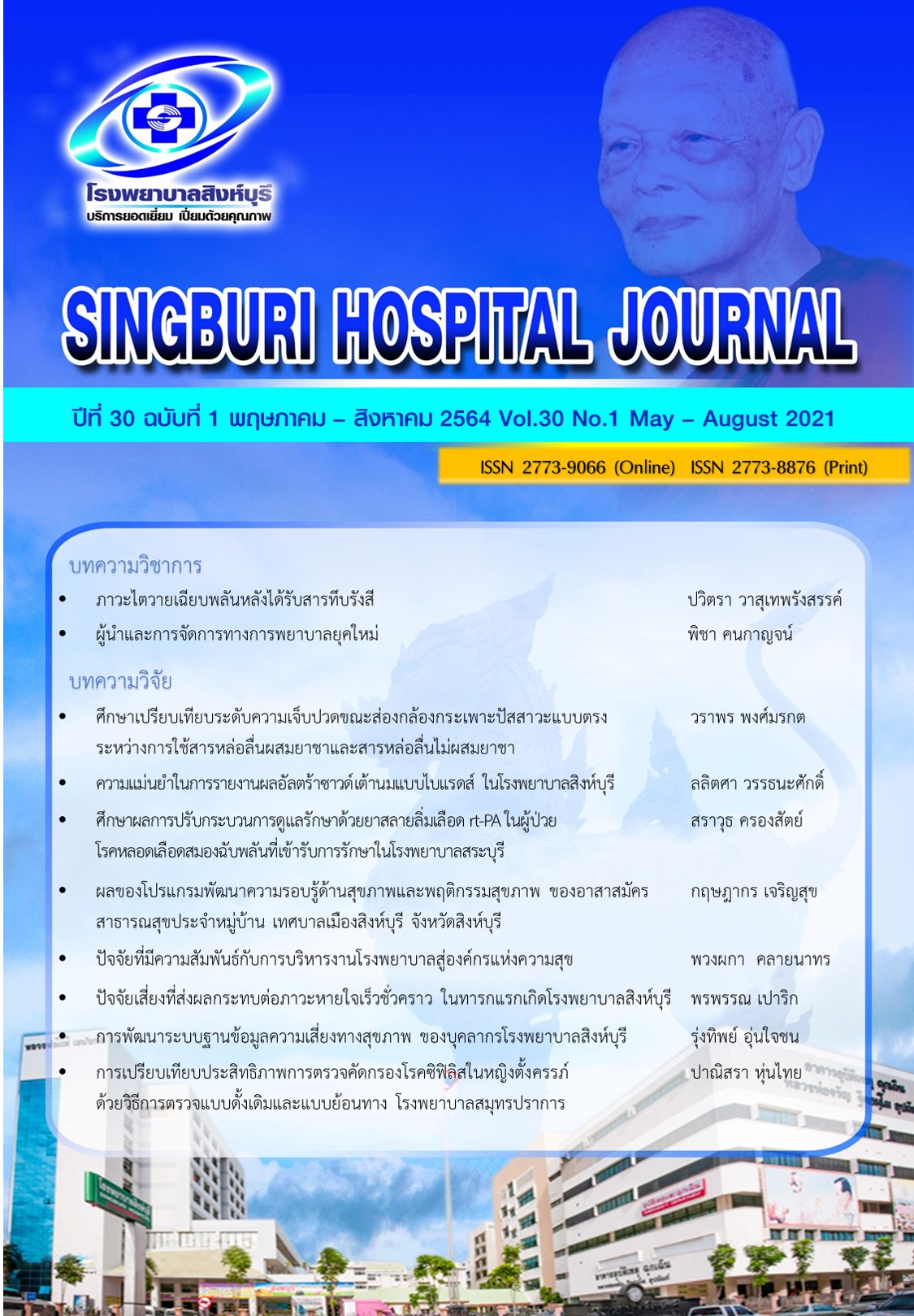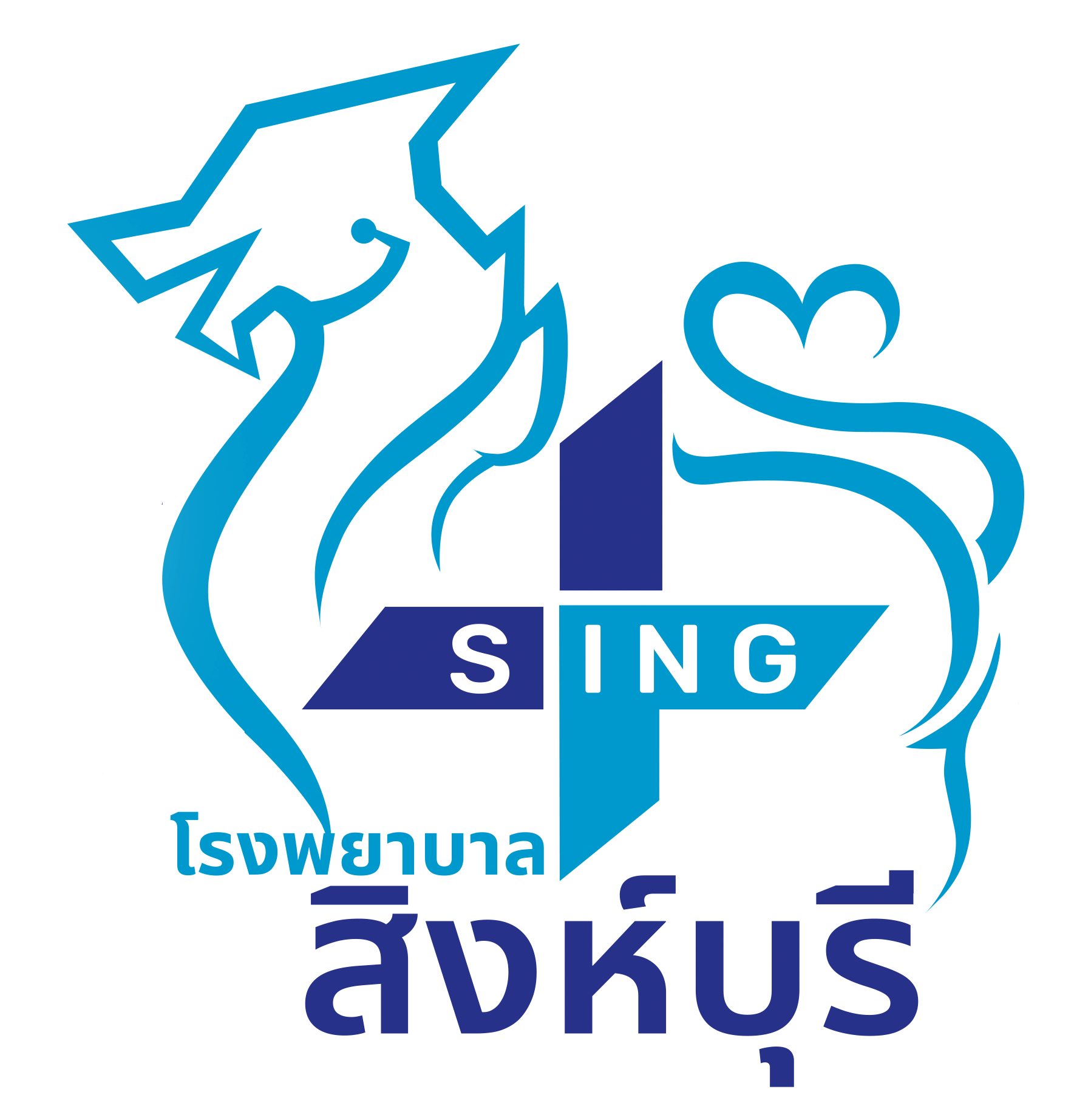ศึกษาผลการปรับกระบวนการดูแลรักษาด้วยยาสลายลิ่มเลือด rt-PA ในผู้ป่วยโรคหลอดเลือดสมองฉับพลันที่เข้ารับการรักษาในโรงพยาบาลสระบุรี
คำสำคัญ:
โรคหลอดเลือดสมอง, ยาสลายลิ่มเลือด rt-PA, National Institute of Health Stroke Scale, Barthel index, modified Rankin Scaleบทคัดย่อ
โรคหลอดเลือดสมองอุดตันเป็นโรคทางระบบประสาทที่เกิดขึ้นฉับพลัน มีผลโดยตรงต่อคุณภาพชีวิต เป็นโรคที่เกิดขึ้นอย่างฉับพลัน ทางผู้วิจัยได้เล็งเห็นปัญหาดังกล่าว ว่าระบบการให้ยาสลายลิ่มเลือด rt-PA ในโรงพยาบาลสระบุรี ยังมีความล่าช้าในกระบวนการรักษา จึงมีการปรับปรุงระบบให้รวดเร็วยิ่งขึ้น โดยตัดกระบวนการที่ไม่จำเป็น วัตถุประสงค์การศึกษา เพื่อศึกษาผลลัพธ์หลังการปรับปรุงระบบ stroke fast track ในการให้ยาสลายลิ่มเลือด rt-PA ที่โรงพยาบาลสระบุรี ได้แก่ ตัวชี้วัดโรคหลอดเลือดสมอง, ภาวะแทรกซ้อนของผู้ป่วยหลอดเลือดสมอง, อัตราการเสียชีวิต, คะแนนความรุนแรงของอาการหลอดเลือดสมอง (National Institute of Health Stroke Scale :NIHSS) คะแนนระดับความพิการของผู้ป่วย (mRS: modified Rankin Scale) และคะแนนการประเมินกิจวัตรประจำวัน ดัชนีบาร์เธลเอดีแอล (Barthel Activities of Daily Living: ADL) กลุ่มประชากร: ผู้ป่วยที่ได้รับการวินิจฉัยว่าเป็นโรคหลอดเลือดสมองตีบหรืออุดตันฉับพลัน และ ได้รับการรักษาด้วยยาสลายลิ่มเลือด rt-PA ตั้งแต่ 1 กุมภาพันธ์ พ.ศ. 2561 ถึง 1 มีนาคม 2563 ที่หอผู้ป่วยโรคหลอดเลือดสมองโรงพยาบาลสระบุรี จำนวนกลุ่มตัวอย่าง 143 ราย การศึกษาแบ่งเป็น 2 กลุ่ม กล่าวคือ กลุ่มที่ 1 เป็นข้อมูลก่อนปรับระบบ stroke fast track ซึ่งเก็บข้อมูลตั้งแต่วันที่ 1 กุมภาพันธ์ พ.ศ. 2561 – 28 กุมภาพันธ์ พ.ศ. 2562 จำนวน 53 ราย และ กลุ่มที่ 2 เป็นข้อมูลหลังปรับระบบ stroke fast track ซึ่งเก็บข้อมูลตั้งแต่ 1 มีนาคม พ.ศ. 2562 – 1 มีนาคม พ.ศ. 2563 จำนวน 90 ราย วิธีการศึกษา เป็นการศึกษาย้อนหลัง ณ จุดเวลาใดเวลาหนึ่งในผู้ป่วยโรคหลอดเลือดสมองของโรงพยาบาลสระบุรี เก็บข้อมูลผู้ป่วยซึ่งประกอบไปด้วย ข้อมูลพื้นฐาน, door to physician, door to lab initiation, door to lab interpretation และ door to needle time, ภาวะแทรกซ้อนของผู้ป่วยหลอดเลือดสมอง อัตราการเสียชีวิตขณะที่ผู้ป่วยนอนในโรงพยาบาล, NIHSS, mRS และ Barthel index วิเคราะห์เปรียบเทียบผลการศึกษาสำหรับข้อมูลเชิงปริมาณ ระหว่าง 2 กลุ่ม คือ ก่อนปรับระบบ และหลังปรับระบบ ว่ามีความแตกต่างอย่างมีนัยสำคัญทางสถิติหรือไม่ด้วยสถิติ t-test (Normal distribution) หรือ Mann-Whitney U test (Non normal distribution) วิเคราะห์ข้อมูลเชิงกลุ่มด้วยสถิติ Chi square test
ผลการศึกษาวิจัย หลังปรับระบบสามารถลดเวลาเฉลี่ยของ Door to physician, Door to lab, Door to lab interpretation, Door to CT initiation, Door to CT interpretation และ Door to needle time ได้ที่ 1.48 นาที, 5.89 นาที, 14.84 นาที, 4.32 นาที 11.87 นาที และ 39.23 นาที เมื่อเทียบกับก่อนปรับระบบอย่างมีนัยสำคัญทางสถิติตามลำดับ (P-value < 0.05) จำนวนผู้เสียชีวิตจากโรคหลอดเลือดสมองอุดตันฉับพลันที่ได้รับยาสลายลิ่มเลือด rt-PA มี 7 ราย (ร้อยละ 13.2) ในกลุ่มก่อนปรับระบบ และ 12 ราย (ร้อยละ 13.3 ) ในกลุ่มหลังปรับระบบ ไม่พบความแตกต่างอย่างมีนัยสำคัญทางสถิติ ส่วนการฟื้นตัวของความพิการทางระบบประสาท (functional outcome) ในกลุ่มหลังเทียบกับกลุ่มก่อนปรับระบบ โดยพิจารณาจากค่า NIHSS , mRS และ Barthel index ไม่พบว่ามีความแตกต่าง อย่างมีนัยสำคัญทางสถิติ สรุป: หลังการปรับปรุงระบบการดูแลผู้ป่วยหลอดเลือดสมองฉับพลัน สามารถลดความล่าช้าในการให้ยาสลายลิ่มเลือด rt-PA ได้ทุกตัวชี้วัดของ Stroke service plan อันได้แก่ door to physician, door to lab, door to lab interpretation, door to CT , door to CT interpretation และ door to needle time ได้อย่างมีนัยสำคัญทางสถิติ เมื่อเทียบกับกลุ่มก่อนปรับระบบ
Downloads
เอกสารอ้างอิง
2. วิโรจน์ ตั้งเจริญเสถียร, และ คณะ. การพัฒนาระบบสุขภาพในประเทศไทย: รากฐานสำคัญของการบรรลุหลักประกันสุขภาพถ้วนหน้า. Lancet. 2018.
3. Warner JJ, Harrington RA, Sacco RL, Elkind MSV. Guidelines for the early management of patients with acute ischemic stroke 2019 update to the 2018 guidelines for the early management of acute ischemic stroke. Stroke. 2019;50(12):3331–2.
4. Atlantis T, Study PA, Investigators G. Association of outcome with early stroke treatment: Pooled analysis of ATLANTIS, ECASS, and NINDS rt-PA stroke trials. Lancet. 2004;363(9411):768–74.
5. Wahlgren N, Ahmed N, Dávalos A, Ford GA, Grond M, Hacke W, et al. Thrombolysis with alteplase for acute ischaemic stroke in the Safe Implementation of Thrombolysis in Stroke-Monitoring Study (SITS-MOST): an observational study. Lancet. 2007;369(9558):275–82.
6. Hacke W, Kaste M, Fieschi C, Von Kummer R, Davalos A, Meier D, et al. Randomised double-blind placebo-controlled trial of thrombolytic therapy with intravenous alteplase in acute ischaemic stroke (ECASS II). Lancet. 1998;352(9136):1245–51.
7. Hanchaiphiboolkul S, Poungvarin N, Nidhinandana S, Suwanwela NC, Puthkhao P, Towanabut S, et al. Prevalence of stroke and stroke risk factors in thailand: Thai epidemiologic stroke (TES) study. J Med Assoc Thail. 2011;94(4):427–36.
8. Bluhmki E, Chamorro Á, Dávalos A, Machnig T, Sauce C, Wahlgren N, et al. Stroke treatment with alteplase given 3·0-4·5 h after onset of acute ischaemic stroke (ECASS III): additional outcomes and subgroup analysis of a randomised controlled trial. Lancet Neurol [Internet]. 2009;8(12):1095–102. Available from: http://dx.doi.org/10.1016/S1474-4422(09)70264-9
9. Emberson J, Lees KR, Lyden P, Blackwell L, Albers G, Bluhmki E, et al. Effect of treatment delay, age, and stroke severity on the effects of intravenous thrombolysis with alteplase for acute ischaemic stroke: A meta-analysis of individual patient data from randomised trials. Lancet. 2014;384(9958):1929–35.
10. Kamal N, Sheng S, Xian Y, Matsouaka R, Hill MD, Bhatt DL, et al. Delays in Door-to-Needle Times and Their Impact on Treatment Time and Outcomes in Get with the Guidelines-Stroke. Stroke. 2017;48(4):946–54.
11. Whiteley WN, Emberson J, Lees KR, Blackwell L, Albers G, Bluhmki E, et al. Risk of intracerebral haemorrhage with alteplase after acute ischaemic stroke: a secondary analysis of an individual patient data meta-analysis. Lancet Neurol. 2016;15(9):925–33.
12. Lyden P. Using the National Institutes of Health Stroke Scale. Stroke. 2017;48(2):513–9.
13. Sulter G, Steen C, Keyser J De. Acute Stroke Trials. Stroke. 1999;1538–41.
14. Powers WJ, Rabinstein AA, Ackerson T, Adeoye OM, Bambakidis NC, Becker K, et al. 2018 Guidelines for the Early Management of Patients With Acute Ischemic Stroke: A Guideline for Healthcare Professionals From the American Heart Association/American Stroke Association. Vol. 49, Stroke. 2018. 46–110 p.
15. Dhaliwal J, Ferrigno B, Abiola O, Moskalik A, Sposito J, Wolansky LJ, et al. Hospital-based intervention to reduce tPA administration time. Interdiscip Neurosurg Adv Tech Case Manag [Internet]. 2019;15(May 2017):15–8. Available from: https://doi.org/10.1016/j.inat.2018.09.005
16. Tekle WG, Chaudhry SA, Fatima Z, Ahmed M, Khalil S, Hassan AE, et al. Intravenous Thrombolysis in Expanded Time Window (3-4.5 hours) in General Practice with Concurrent Availability of Endovascular Treatment. J Vasc Interv Neurol. 2012;5(1):22–226.
17. Marler JR, Tilley BC, Lu M, Brott TG, Lyden PC, Grotta JC, et al. Early stroke treatment associated with better outcome: The NINDS rt-PA Stroke Study. Neurology. 2000;55(11):1649–55.
18. Fonarow GC, Smith EE, Saver JL, Reeves MJ, Hernandez AF, Peterson ED, et al. Improving door-to-needle times in acute ischemic stroke: The design and rationale for the American Heart Association/American Stroke Association’s target: Stroke initiative. Stroke. 2011;42(10):2983–9.
ดาวน์โหลด
เผยแพร่แล้ว
รูปแบบการอ้างอิง
ฉบับ
ประเภทบทความ
สัญญาอนุญาต
บทความที่ได้รับการตีพิมพ์เป็นลิขสิทธิ์ของโรงพยาบาลสิงห์บุรี
ข้อความที่ปรากฏในบทความแต่ละเรื่องในวารสารวิชาการเล่มนี้เป็นความคิดเห็นส่วนตัวของผู้เขียนแต่ละท่านไม่เกี่ยวข้องกับโรงพยาบาลสิงห์บุรี และบุคคลากรท่านอื่นๆในโรงพยาบาลฯ แต่อย่างใด ความรับผิดชอบองค์ประกอบทั้งหมดของบทความแต่ละเรื่องเป็นของผู้เขียนแต่ละท่าน หากมีความผิดพลาดใดๆ ผู้เขียนแต่ละท่านจะรับผิดชอบบทความของตนเองแต่ผู้เดียว







